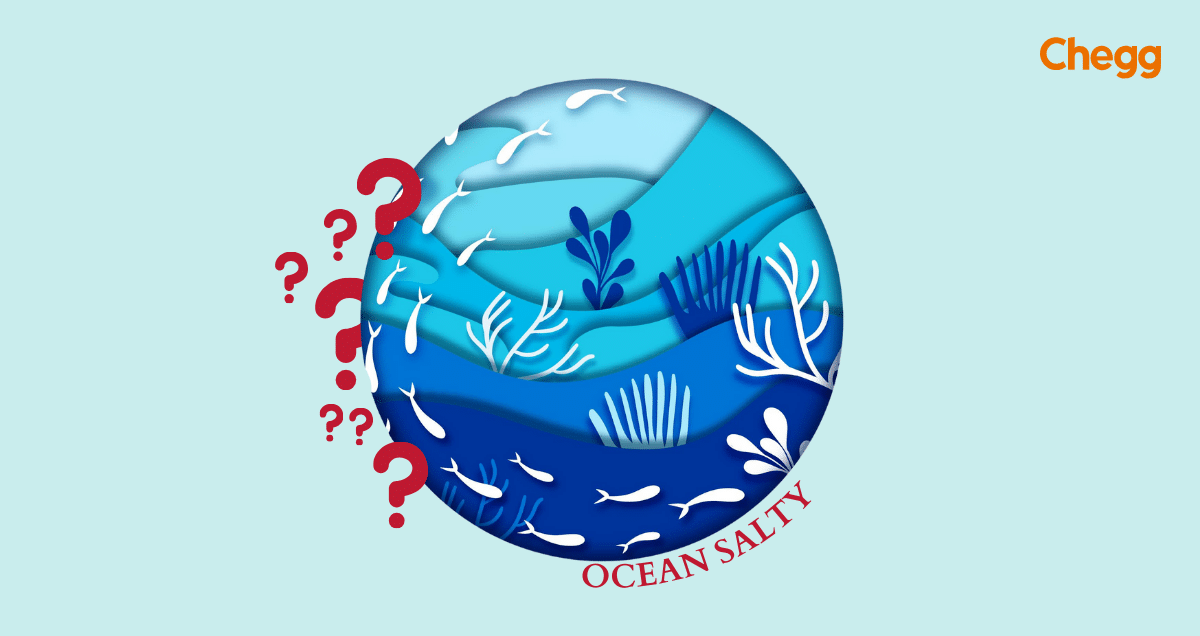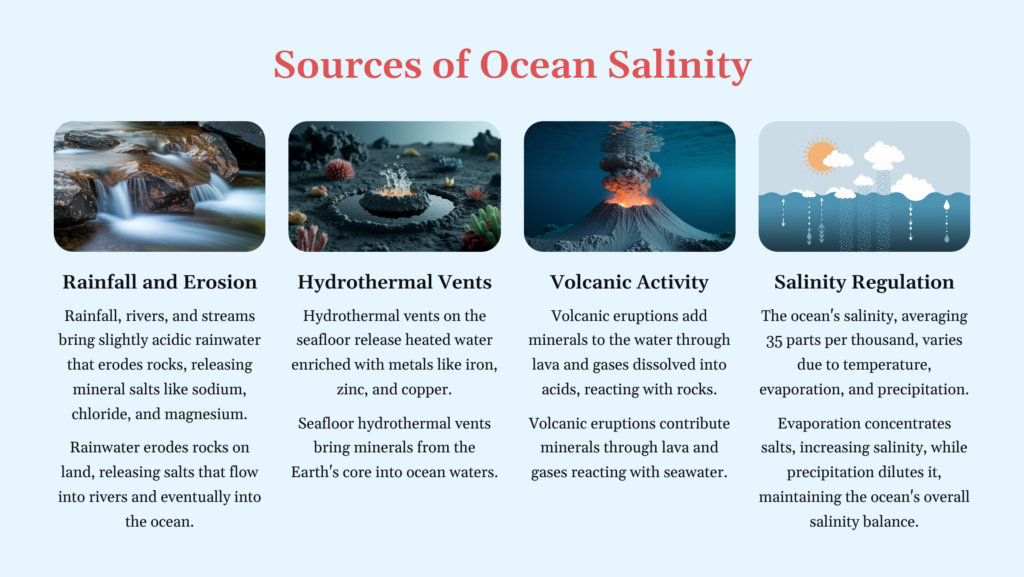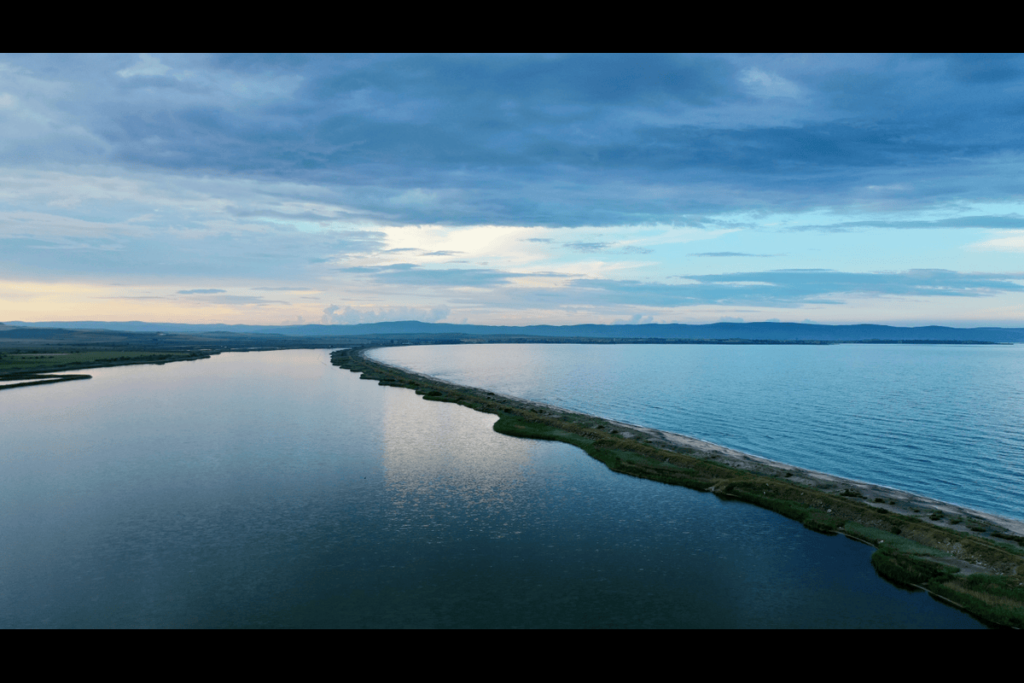
Quick Summary
Table of Contents
Why is the ocean salty? This seemingly simple question reveals a complex and captivating story spanning billions of years and involving the intricate interplay of natural forces. Join us as we delve into this salty mystery and uncover the fascinating secrets beneath the ocean’s surface. Moving ahead, we will be using sea and ocean interchangeably since the only significant difference between the two is their size. Below is a short poem on the question, “How salty is the ocean?”
Why is the ocean salty, you say?
It gathers salt along the way.
That’s how salt is formed in sea water,
From rocks and rivers it does slaughter.
Sea water salinity starts to grow,
As sun pulls water, salts don’t go.
Ocean salinity builds each year,
A briny tale both wide and clear.
Have you ever gone swimming in the ocean and accidentally got a mouthful of salty water? Yuck, right? But have you ever wondered why the ocean is salty in the first place?
The salt in the ocean comes from rocks, rivers, underwater volcanoes, and tiny vents on the ocean floor. Rain slowly wears away rocks and picks up minerals, including salt, when it falls on land. These minerals get washed into rivers, and the rivers carry them to the ocean. Over a long, long time, all that salt adds up!
The Earth is mainly covered by water—about 71% of it! There are five big oceans: the Pacific, Atlantic, Indian, Southern, and Arctic. Each one is different in size, depth, and temperature. Oceans also help us by giving us oxygen, keeping the weather cool, and being home to many sea animals.
Out of all the oceans, the Atlantic Ocean is the saltiest. That’s because it gets a lot of sun, which makes water evaporate (turn into gas) faster. When the water goes up into the air, the salt stays behind, making the water even saltier.
Pretty cool, right? The next time you’re near the ocean, remember that every salty wave has traveled a long journey through nature!

Unlocking the Secrets for Why Is the Ocean Salty:

Salinity can be defined as the amount of dissolved salts, mеasurеd in parts pеr thousand (ppt), in a unit volumе of sеawatеr. The average salinity of the world’s oceans is about 35 ppt, meaning there are roughly 35 grams of dissolvеd salts in every liter of sea water. It’s еssеntial to note that salinity is not a constant value and can vary from one location to another and with depth in the ocean.
Why is the ocean salty? The salinity of ocean water results from various natural processes, including the continuous cycling of water through the Earth’s hydrological system. Why Is the Ocean Salty? When water from rivers, lakes, and oceans evaporates, it leaves salts behind, increasing salinity. Why Is the Ocean Salty? Conversely, when precipitation replenishes these bodies of water, it dilutes the salinity. Why Is the Ocean Salty? The Earth’s oceans are interconnected, and the mixing of sea water with freshwater from rivers and ice melt further influences the overall salinity of the world’s oceans. Why Is the Ocean Salty?
Also Read:-
The Wettest Place on Earth: An Easy Guide
Biggest Bird in the World: A Simple Exploration
World Earth Day: Environmеntal Awarеnеss, Education.
While rivers also carry dissolved minerals to the ocean, their salt contribution is dwarfed by the immense amount released through weathering over vast geological timescales. Additionally, some minerals are used by marine organisms or form insoluble compounds that settle on the ocean floor, preventing them from accumulating like sodium and chloride.
Have you ever wondered why the ocean is salty but the lake near your house isn’t? It all boils down to water flow and the type of minerals involved.
So, constant freshwater inflow and a lack of sodium and chloride keep most lakes tasting fresh. At the same time, the oceans become salty pools due to minimal freshwater input and high evaporation.
One of the biggest reasons for varying ocean salinity is the water cycle, especially evaporation and precipitation. When sea water evaporates under the sun’s heat, the water becomes vapor and rises—but the salt stays behind. This increases sea water salinity in those areas. That’s how salt is formed in sea water over time.
On the other hand, areas with heavy rainfall, like the equator, receive a steady freshwater supply. This dilutes the salty ocean water, lowering salinity levels. There is a constant tug-of-war between water leaving and entering the ocean.
In colder regions, like the Arctic and Antarctic, melting ice sheets and glaciers release large amounts of freshwater into the ocean. Since this water has almost no salt, it mixes with the surrounding sea, decreasing ocean salinity. That’s why polar oceans have lower salinity levels than tropical waters.
The global ocean circulation system is key in spreading salt across the seas. Warm surface currents carry saltier water from the equator toward the poles, while colder deep currents transport less salty water back toward the equator. This constant movement helps redistribute sea water salinity, preventing extreme salt build-up in any region.
Tеmpеraturе affеcts thе solubility of salt in watеr. Coldеr watеr can hold morе dissolvеd salts, whilе warmеr watеr has a lowеr solubility for salts. This results in variations in salinity based on tеmpеraturе, with warmеr rеgions tеnding to havе lowеr salinity and coldеr rеgions having highеr salinity. The salinity levels in various oceans vary due to a combination of thе factors mеntionеd abovе:
The Atlantic Ocean is generally saltier than others. In the north, the Gulf Stream contributes to higher salinity by bringing warm, salty water. In the south, freshwater inflow slightly reduces salt levels, but overall, the Atlantic shows moderate to high sea water salinity.
The Pacific, being the largest ocean, has more variation. Its eastern side has lower salinity due to cooler temperatures and more rain, while the western Pacific is saltier thanks to warmer water and less precipitation.
The Indian Ocean features noticeable salinity differences. The western region is saltier due to higher evaporation and limited river inflow, whereas the eastern part gets diluted during monsoon seasons and from rivers like the Ganges.
Surrounded by ice and major river systems, the Arctic Ocean has some of Earth’s lowest ocean salinity levels. Freshwater from melting ice and river runoff continuously dilutes the sea water here
The vast oceans may appear to be a giant bowl of ever-increasing salt, yet their salinity has remained remarkably stable over millions of years. Here’s why:
| Feature | Freshwater | Saltwater |
| Salinity | Low salinity (0.5% or less) | High salinity (around 3.5%) |
| Sources | Rivers, lakes, streams, ponds | Oceans, seas |
| Density | Less dense than saltwater | More dense due to higher salt content |
| Ecosystem | Denser due to higher salt content | Supports marine life like fish, crustaceans, and corals |
| pH Levels | Generally neutral (around 7) | Can be more alkaline (7.5-8.4) |
| Oxygen Levels | Higher oxygen levels in surface waters | Varies; often lower in deeper areas |
| Temperature | Can vary widely, affected by weather | More stable temperatures |
| Usage | Drinking water, irrigation, recreation | Transportation, fishing, tourism |
| Geographical Spread | Found globally but in limited areas | Covers about 71% of the Earth’s surface |

So, why is the ocean salty? Rain-eroding rocks, rivers carrying dissolved salts to the sea, hydrothermal vents adding minerals, and the sun evaporating surface water are the causes. This continuous process explains how salt is formed in sea water and maintains a stable level of ocean salinity through natural cycles.
Ocean salinity is more than a curious fact. It helps regulate ocean temperature, supports marine ecosystems, and influences global climate patterns. Without this perfect balance, ocean life wouldn’t thrive as it does today.
The ocean is salty because of the salts from rocks on land and openings in the seafloor.
The Atlantic Ocean is the saltiest of the five major ocean basins. However, salinity levels near the equator and both poles decrease noticeably, influenced by distinct environmental factors in each region.
The Earth’s waters derive their salt content primarily from three key sources: the dissolution of salts from rocks and soil, precipitation, and the continuous cycle of evaporation and precipitation.
The ocean is an immense body of saltwater, covering approximately 71% of Earth’s surface.
All five oceans—the Atlantic, Indian, Southern, Arctic, and Pacific—are saltwater. Saltwater is characterized by dissolved salts, primarily sodium chloride (NaCl).
The ocean is salty primarily due to the gradual process of rock weathering on land. Rainwater dissolves minerals and salts from rocks and carries them into rivers, eventually flowing into the ocean. Over millions of years, this accumulation of dissolved salts has made the sea salty.

Authored by, Amay Mathur | Senior Editor




Amay Mathur is a business news reporter at Chegg.com. He previously worked for PCMag, Business Insider, The Messenger, and ZDNET as a reporter and copyeditor. His areas of coverage encompass tech, business, strategy, finance, and even space. He is a Columbia University graduate.
Editor's Recommendations
Chegg India does not ask for money to offer any opportunity with the company. We request you to be vigilant before sharing your personal and financial information with any third party. Beware of fraudulent activities claiming affiliation with our company and promising monetary rewards or benefits. Chegg India shall not be responsible for any losses resulting from such activities.
Chegg India does not ask for money to offer any opportunity with the company. We request you to be vigilant before sharing your personal and financial information with any third party. Beware of fraudulent activities claiming affiliation with our company and promising monetary rewards or benefits. Chegg India shall not be responsible for any losses resulting from such activities.